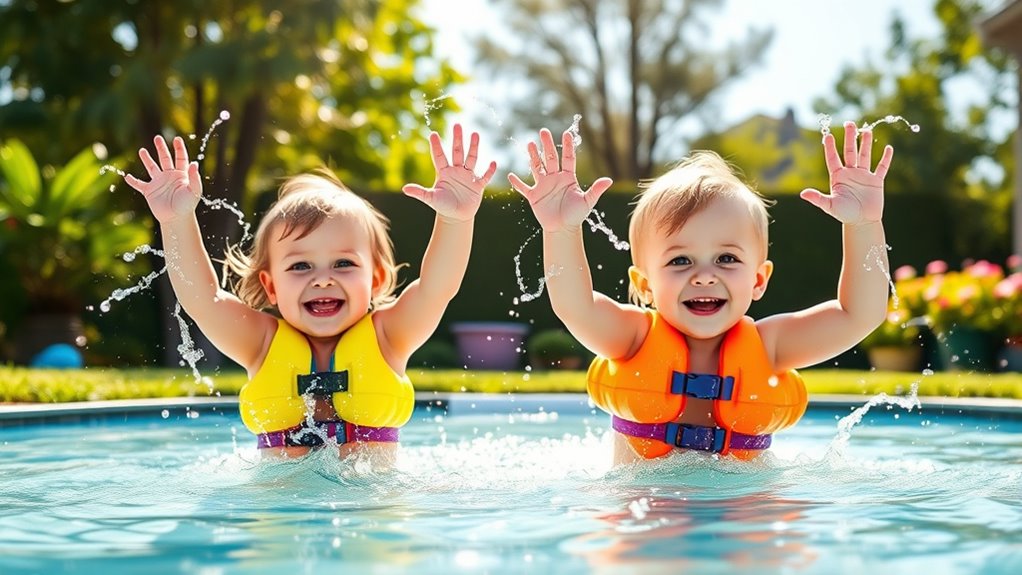To guarantee water play is safe and fun for your toddler, choose shallow areas with clear boundaries and avoid hazards like sharp objects. Always supervise closely, keeping water activities within arm’s reach, and be prepared to respond quickly in emergencies. Use age-appropriate toys and maintain clean, properly heated water. By following safety tips and teaching water awareness, you can create an enjoyable water experience. Keep exploring to learn more essential safety strategies.
Key Takeaways
- Ensure water is shallow, temperature is comfortable, and play areas are free of hazards for toddler safety.
- Maintain constant supervision and be prepared with emergency skills like CPR and rescue techniques.
- Use age-appropriate, durable water toys, regularly inspecting them for damage or sharp edges.
- Teach toddlers water safety rules, including no swimming alone and recognizing safety signals.
- Keep water clean, filtered, and at a safe temperature to promote healthy, enjoyable water play.
Choosing Safe Water Play Areas
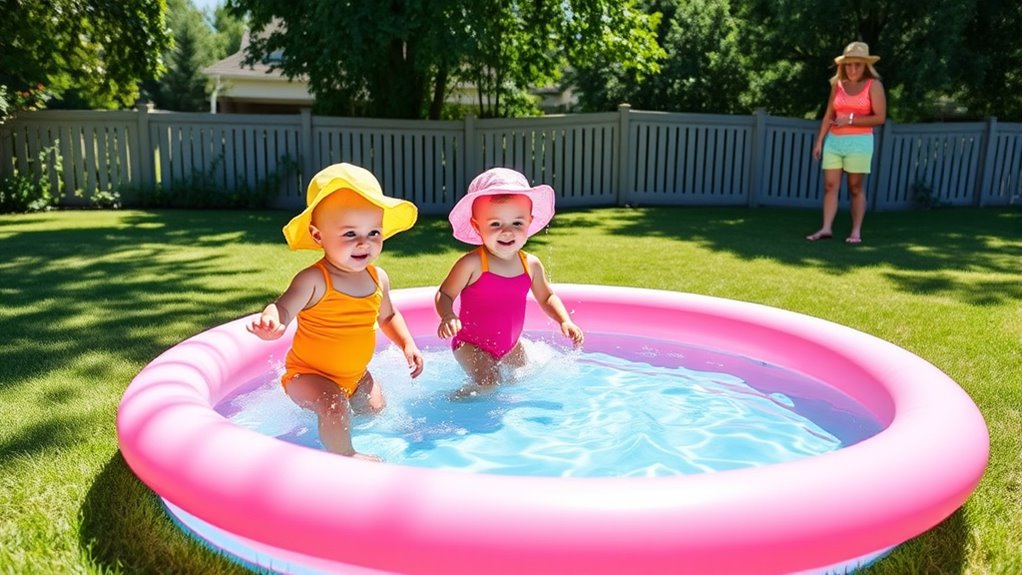
When selecting a water play area for your toddler, safety should be your top priority. First, check that the water temperature is comfortable—neither too hot nor too cold—so your child won’t get chilled or overheated. Always confirm the water depth is shallow, ideally no more than a few inches, to prevent any risk of drowning. Look for areas with clear boundaries, such as shallow wading pools or splash pads, that allow you to keep an eye on your child at all times. Avoid areas with uneven surfaces or sharp objects that could cause injuries. By carefully evaluating water temperature and depth, you create a safe environment where your toddler can enjoy water play without unnecessary risks. Additionally, inspecting the water quality of the play area ensures that your child is not exposed to harmful bacteria or chemicals. Maintaining proper water hygiene is crucial for preventing infections and ensuring a healthy water play experience. Regularly checking for contaminants helps ensure the safety and well-being of your child during water activities. Implementing appropriate filtration systems can also significantly improve water cleanliness and safety. Remember that supervision is key to preventing accidents and ensuring your child’s safety at all times.
Supervision and Constant Vigilance
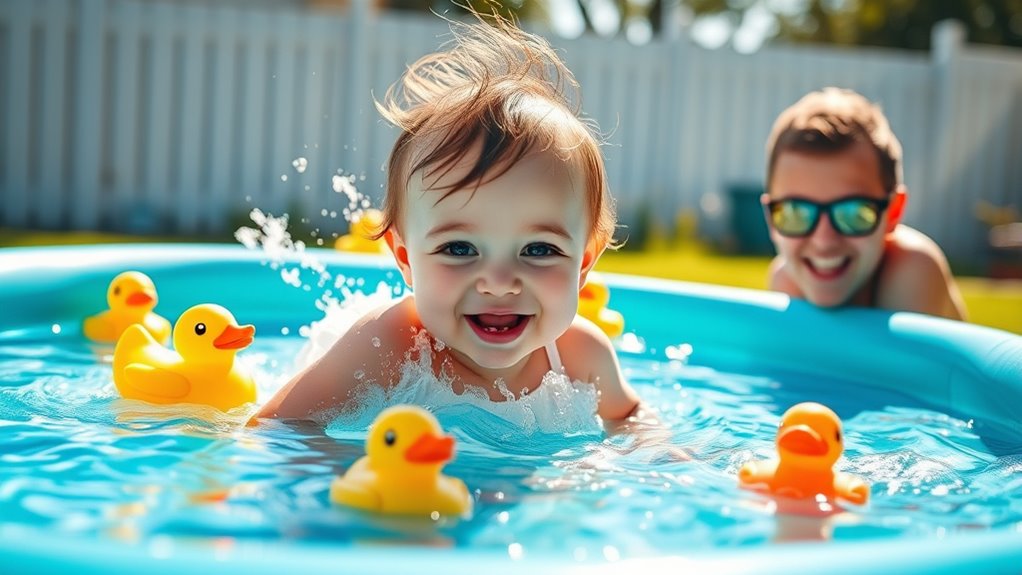
Supervision is essential during your toddler’s water play to prevent accidents and guarantee their safety. Always keep a close eye on them, especially near water that might have an unsafe temperature or contamination. Make certain the water is warm enough to avoid chills but not too hot, which could cause burns. Check regularly for water contamination, such as dirt or chemicals, that could harm your child if ingested or come into contact with their skin. Never leave your toddler unattended, even for a moment, as drowning can happen quickly and silently. Stay vigilant, stay engaged, and be ready to respond immediately if needed. Constant supervision helps you catch hazards early, keeping water play safe and enjoyable for your little one. Proper supervision practices are critical for ensuring your child’s safety during water activities.
Using Appropriate Water Toys and Equipment
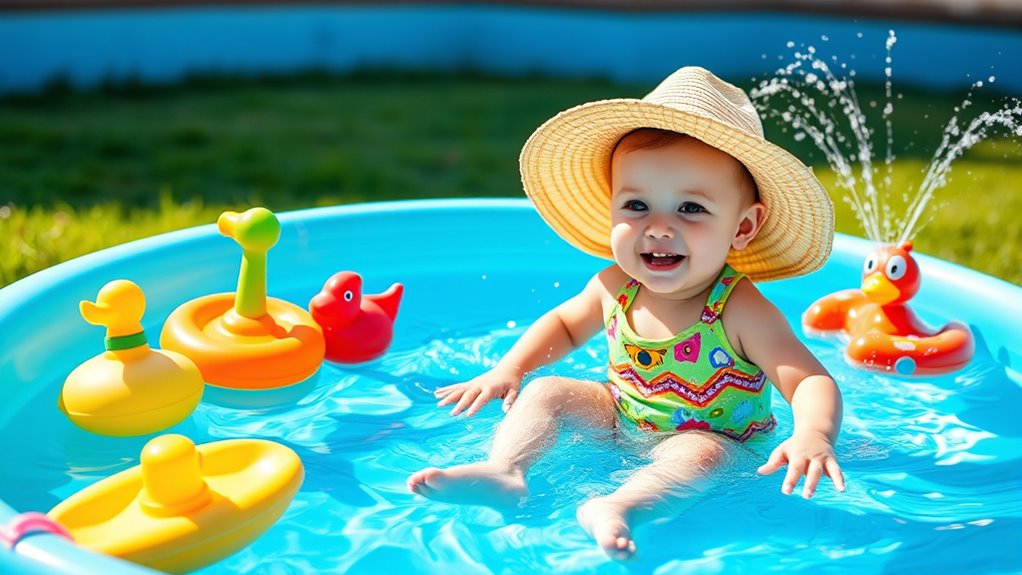
Choosing the right water toys and equipment can make water play safer and more enjoyable for your toddler. Focus on water toy selection that’s age-appropriate, durable, and free of small parts. Always prioritize water equipment safety by inspecting toys for sharp edges or broken parts. Self Watering Plant Pots are an example of innovative watering solutions that promote healthy plant growth while reducing maintenance. Incorporating high-quality paint sprayer tips can also help ensure a smooth and clean application when decorating outdoor water play areas, making the experience more fun and safe for your child. Additionally, understanding best anime movies can inspire creative play and storytelling during water activities. Celebrity lifestyle insights suggest that incorporating appropriate gear can enhance safety and add to the fun of water activities.
Teaching Water Safety Skills

You need to supervise your toddler closely whenever they’re near water to prevent accidents. Teach them simple water safety rules, like never swimming alone or running around the pool. Consistent monitoring and clear guidelines help your child stay safe while having fun. Additionally, teaching children about water safety skills can significantly reduce the risk of water-related incidents. Understanding trauma-informed practices and how to communicate effectively in emergencies can further enhance safety. Recognizing behavioral support strategies can also help in managing your child’s reactions during water activities, ensuring a safer experience for everyone. Implementing safety protocols and regular practice can reinforce safe behaviors around water, making safety an integral part of playtime. Understanding divorce costs and preparing accordingly can also help parents manage the financial aspects of separation if needed.
Supervision and Close Monitoring
Because toddlers are naturally curious and enthusiastic to explore, constant supervision is essential when they’re around water. You need to stay within arm’s reach at all times, watching closely to prevent accidents. Effective toddler supervision means actively engaging with your child, not just being nearby. Keep your eyes on them, even if they seem to be having fun or acting cautious. Remember, water safety depends on your vigilance; a moment of distraction can lead to dangerous situations. Use your voice and gentle guidance to reinforce safe behaviors. Never leave your toddler unattended, even for a second. Close monitoring creates a safe environment where your child can enjoy water play while reducing the risk of accidents. Your attentive supervision is your best defense in ensuring water fun remains safe. Additionally, understanding water safety skills can further help your child develop healthy habits around water. Incorporating remote work productivity strategies such as focused attention can help you stay alert while supervising your toddler. Developing water safety awareness through practice and education can strengthen your child’s understanding of safe water behaviors. Being familiar with child drowning prevention techniques can also make a critical difference in emergency situations. Regularly practicing water rescue techniques with your child can prepare both of you for unexpected situations.
Learn Water Safety Rules
How can toddlers learn essential water safety rules to stay protected during water play? Start by teaching them about water safety signs, such as “Stay Close” or “No Running,” so they recognize important cues. Emphasize drowning prevention by explaining that they should never go near water alone. Use simple, clear instructions to help them understand. To deepen their knowledge, focus on these key points:
- Always stay within arm’s reach of an adult during water play.
- Recognize and obey water safety signs and signals.
- Understand that water is not a toy and must be treated with respect.
Reinforcing these rules helps toddlers develop safe habits and reduces risks during water activities. Consistent guidance ensures they learn to enjoy water safely.
Recognizing and Responding to Water Emergencies
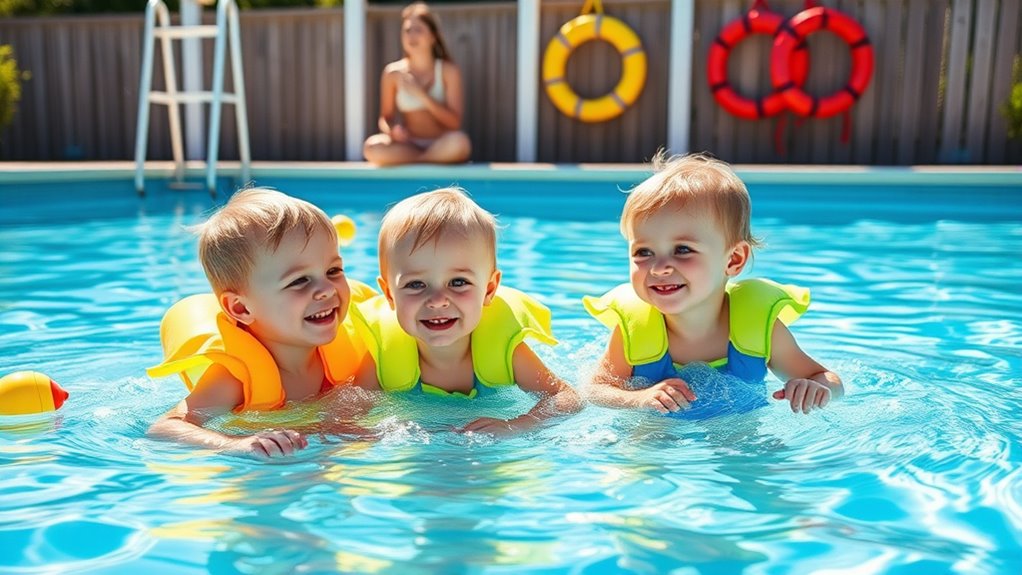
Recognizing the signs of a water emergency quickly can make all the difference in keeping your toddler safe. Watch for sudden changes in breath, loss of movement, or if they’re not responding. If you suspect an emergency, act immediately with rescue techniques like reaching, throwing, or wading—never diving, to avoid risking your safety. Stay calm and call for emergency assistance right away. Your emergency preparedness is essential; keep a phone nearby, and know CPR and basic rescue methods. Quickly evaluating the situation allows you to respond effectively, preventing tragedy. Remember, quick action combined with calm decision-making can save your child’s life. Stay alert, prepared, and confident—your quick response is critical during water emergencies. Being familiar with water play safety, including proper supervision and safety measures, is also vital to prevent accidents before they happen.
Creating a Water Play Environment Free of Hazards
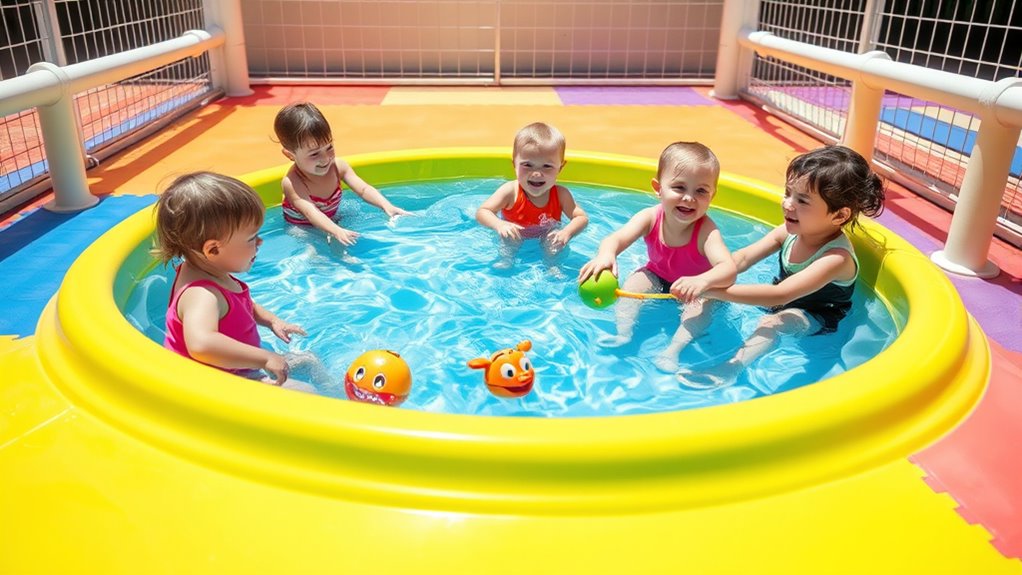
Creating a safe water play environment starts with identifying and removing potential hazards before your child begins to play. Ensuring water temperature stays within a safe range prevents burns or chills. Regularly check water temperature to keep it comfortable and safe. Proper water filtration maintains clean water, reducing bacteria and debris that could cause illness. To create a hazard-free space, focus on these key areas:
Ensure water temperature is safe and water is clean to keep your child safe during water play.
- Maintain water temperature consistently, avoiding extremes.
- Use reliable water filtration systems to keep water clean.
- Remove sharp objects, toys, or debris that could cause injury.
Frequently Asked Questions
What Are Signs of Water Distress in Toddlers?
You should watch for signs of water distress in toddlers, like coughing, struggling to breathe, or panic. If your toddler wears water goggles or a life jacket, monitor their comfort and reactions closely. Look for signs of fatigue, disorientation, or crying, which could indicate they’re overwhelmed. Stay attentive, keep a close eye, and be ready to help immediately if you notice any distress signals during water play.
How Can I Prevent Sunburn During Water Play?
Imagine your toddler turning into a lobster at water play—funny, but not so much for their skin. To prevent sunburn, you should apply sunscreen generously before they hit the water, reapplying often. Don’t forget protective clothing like hats and rash guards to shield their delicate skin. These simple steps turn sun protection into a playful routine, keeping your little one safe and happy while splashing around.
Are There Age-Appropriate Water Toys for Toddlers?
You’ll find plenty of age-appropriate toys that suit your toddler’s developmental stage. Look for toys made from non-toxic, durable materials with no small parts, following safety guidelines. Soft, floating toys or water squirters are perfect for little hands and safe play. Always supervise your child and choose toys designed specifically for their age to guarantee a safe, enjoyable water play experience.
How Often Should Water Play Areas Be Sanitized?
You should sanitize water play areas at least daily to prevent water contamination and guarantee chemical safety. Regular cleaning removes bacteria and mold, reducing the risk of illnesses. Always check for signs of dirt or algae, and use child-safe disinfectants. By maintaining a clean environment, you protect your toddler’s health, making water play both fun and safe. Consistent sanitation helps keep the water fresh and free from harmful germs.
What Are Emergency Contact Procedures for Water Incidents?
When a water incident occurs, you should immediately follow your emergency contact procedures. Make certain you know rescue techniques to assist the child safely, avoiding further risk. Call emergency services if needed, and have an emergency kit ready with first aid supplies. Stay calm, monitor the child’s condition, and provide reassurance while waiting for professional help. Clear communication and swift action are key to handling water incidents effectively.
Conclusion
Ensuring safe water play for your toddler is essential for fun and learning. Did you know that drowning is the leading cause of accidental death for children ages 1-4? By choosing safe areas, supervising constantly, and teaching water safety skills, you can markedly reduce risks. Keep hazards away and use appropriate toys to create a secure environment. With these steps, you’ll help your little one enjoy water play safely and confidently, making every splash a positive experience.

